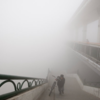Atmospheric Emissions
2016
Feb
25
New York Times and VICE News Quote Nielsen on China's CO2 and Air Pollution Control
2015
May
15
New York Times Cites China Project Symposium and Investigation
"China 2035" Lecture Series Features Michael Spence, Robert Zoellick, and Kevin Rudd
The Economist, China Daily Cite China Project Research, also Subject of New York Times Op-Ed
2014
Feb
06
2013
Nov
07
In the Spotlight - Air Pollution
China's CO2 Emissions
2013
Apr
08
2013
Feb
12
. 2018. “Contribution of hydroxymethane sulfonate to ambient particulate matter: A potential explanation for high particulate sulfur during severe winter haze in Beijing.” Geophysical Research Letters, 45, Pp. 11969-11979. Publisher's VersionAbstract
2010
Oct
14
2010
Sep
09





